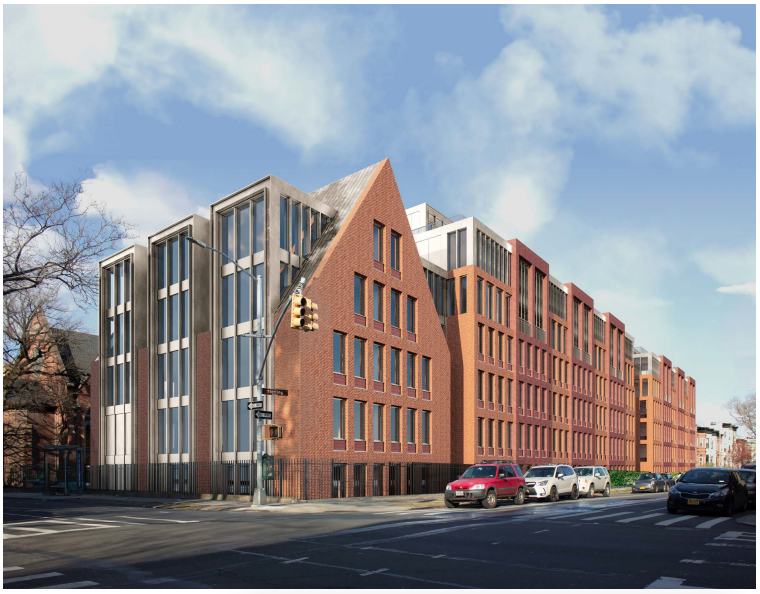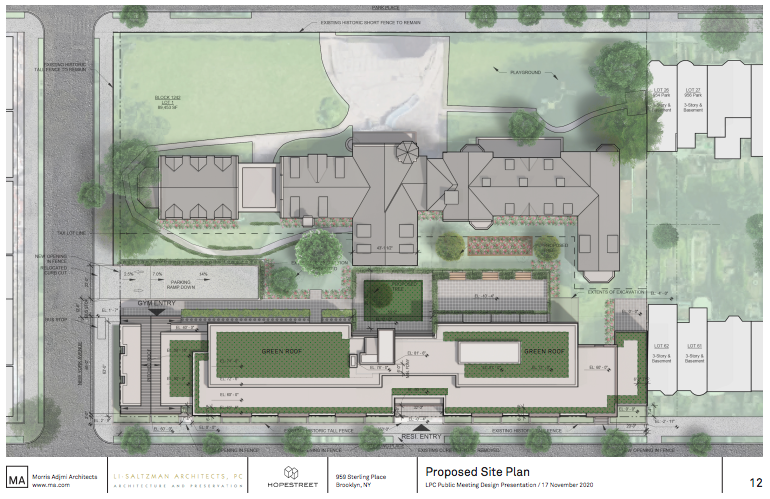Landmarks Preservation Commission Pumps The Brakes On New Development At 959 Sterling Place


The city’s Landmarks Preservation Commission decided on Tuesday to postpone its vote on a proposal to build a seven-story residential building next to the historic Methodist Home for the Aged building in Crown Heights.
While LPC’s commissioners said they did not oppose development at 959 Sterling Place, a mostly unused back lot with some parking spaces immediately adjacent to the Methodist Home, they said the design proposed by developer Hope Street Capital did not match the context of the surrounding Crown Heights North historic district.
“Certainly, this site can sustain a substantial amount of development,” said Commissioner John Gustafsson at the LPC’s November 17th meeting. “But this is not it.”
The proposal, designed and presented by the architect Morris Adjmi, fits within the area’s current zoning but requires a Certificate of Appropriateness from LPC because of its location within the historic district.
The project would add 182 units of housing to the northeast corner of Sterling Place and New York Avenue. The proposal also seeks to demolish a small southern portion of the Methodist Home, transform the remaining area between the two buildings into a publicly accessible green space, and create an underground area with 142 parking spaces, bike storage, a gym, and laundry facilities.

Adjmi argued that his 80-foot-tall building would be a contextually appropriate addition to the historic district, citing the similar heights of nearby buildings and his use of design cues taken from the Methodist Home. But several Commissioners expressed concern about the proposed structure’s imposing half-block length, as well as the extensive use of metal and glass in its design.
“I do think the metal materiality doesn’t really work that well,” said Commissioner Jeanne Lufty. “More undulation, or separate buildings with materials that work more harmoniously with the area, I think would be helpful.”
Some Commissioners also expressed a desire to maintain the site’s “campus feel” and suggested reshaping the buildings and creating easier access to the interior courtyard.
“There needs to be a breaking up of the masses and reducing the scale,” said Commissioner Wellington Chen. “I think it’s the right direction to go to create the campus feel, with more landscaping, with reduced height and more articulation, lower rooflines, and multiple recessed courtyards.”
The LPC did not allow for public comment at the November 17th meeting, because it had already done so at an earlier meeting in October.

The redevelopment proposal was set into motion by the Northeast Conference of the Seventh Day Adventist Church, the owners of the site. The Conference says the development will help pay for badly-needed repairs to the Methodist Home building, which now holds the Hebron Seventh Day Adventist Bilingual School.
But it has also generated fierce opposition from many local residents, who have raised a variety of environmental, affordability, and aesthetic concerns. Nearly 7,000 people have signed an online petition opposing the development, and the local community board’s land use committee voted 14-to-2 to withhold support.
Hope Street Capital has said it is committed to setting aside 30% of the building’s units for below-market-rate housing under the city’s Affordable Housing New York program. But the program gives developers a wide berth in defining the terms of that affordability, and community advocates are skeptical that new units will address their housing needs.
In a statement provided to Bklyner, the neighborhood group Friends of 920 Park, which opposes development on the site, said they were frustrated that LPC had not rejected the application entirely.
“Despite unprecedented public opposition, the Commission did what they always do: they gave the developer a second chance,” the statement read. “To negotiate with developers who propose egregious projects like this one is not adequate protection for our historic districts, and we do not feel this decision honors the Commission’s mandate to preserve the city’s landmarks. We will continue to fight for our neighborhood and to prevent Hope Street Capital from desecrating our historic district, contributing to relentless gentrification, and making a quick buck on the health and wellbeing of our neighbors.”
Several local elected officials, including Council Member Robert Cornegy, State Senator-elect Jabari Brisport, and Assemblymember-elect Phara Souffrant Forrest, have also voiced opposition to the plan, as has the Municipal Art Society of New York. But landmarking proposals do not go before the Mayor or City Council, so LPC will have the final say on the project.
Hope Street Capital did not respond to a request for comment on this article.




